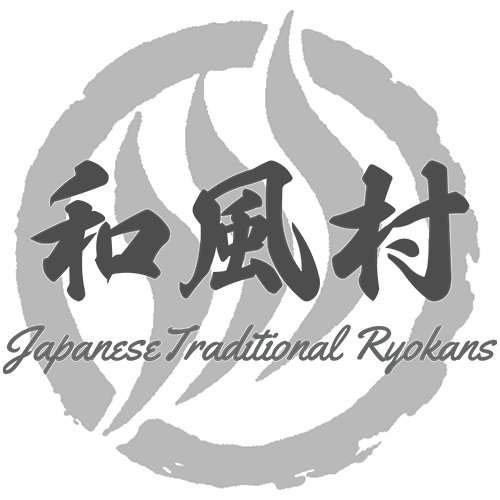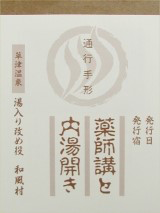


昭和59(1984)年から始まった和風村(古き良き時代の草津温泉を再現しようと集まった15軒の老舗旅館の総称)の内湯を巡る「薬師講と内湯開き」ですが、令和5(2023)年7月28日をもって「湯めぐり手形」の販売を終了させていただくこととなりました。
長きにわたり、多くのお客様にご愛顧いただけましたこと、心より感謝申し上げます。
今後も、和風村ではお客様にご満足いただけるよう尽力して参りますので、何卒よろしくお願いいたします。
なお、既に「湯めぐり手形」をお持ちのお客様につきましては、手形に記載されている発行日から2年間はご利用いただけます。
As of July 28, 2023, we regret to announce that the sale of "Yumeguri Tegata" for the Wafu mura bath tour, "Yakushikou" and "Uchiyu hiraki," began in 1984 (Showa 59), featuring a group of 15 long-established ryokan aiming to recreate the authentic past of traditional Kusatsu Onsen, will be discontinued.
We sincerely appreciate the many customers who have supported us over the years.
We will continue to strive to ensure customer satisfaction at the Wafu mura, and we kindly ask for your continued support.
Additionally, for customers who already possess the "Yumeguri Tegata," it can be used for up to two years from the issuance date stated on the tegata.
古来よりその効能が認められ、多くの人々が入湯に訪れた草津温泉。
湯治のために長期滞在をし、「時間湯」という方法でその病を治していきました。
江戸時代には、徳川将軍の耳にも草津温泉の効能は伝わり、湯畑から湯を汲み上げ、樽に詰めて八代将軍吉宗公の元に運びました。
第二次世界大戦後、草津温泉は観光地としても繁栄し、現在に至っております。
数ある草津温泉の宿の中で、特に日本式の温泉情緒を重んじる老舗旅館が集まり、昭和59(1984)年に和風村が生まれました。
From ancient times, the healing properties of Kusatsu Onsen have been recognized, attracting many visitors seeking the benefits of its hot springs.
People used to stay long term for medical treatment, utilizing a method called "Jikanyu" to heal their ailments.
During the Edo period, the efficacies of Kusatsu Onsen even reached the ears of the Tokugawa shogun.
Water was drawn from Yubatake, bottled in barrels, and transported to the shogun Tokugawa Yoshimune.
After World War II, Kusatsu Onsen flourished as a tourist destination and has continued to prosper to this day.
Among the various accommodations in Kusatsu Onsen, there are longstanding ryokan that particularly value the traditional Japanese hot spring ambiance, leading to the establishment of "Wafu Mura" in 1984.
江戸後期に板行された草津温泉のいくつかの絵図には、氷室のある「氷谷」という名所が描かれています。
氷谷は、現在の草津温泉スキー場天狗山ゲレンデの中腹にあります。
氷谷の洞窟(氷室)の中には、天然に形成された氷が夏でも残っています。
旧暦の6月1日(氷の朔日ついたち)には、湯宿の長が氷谷に登り、氷室から持ち帰った氷に石楠花の花を添えて、客膳に供する風習がありました。
この行事を「氷室の節句」といい、江戸時代から大正末頃まで続きました。
『草津薬泉之記』 巣萑子作 宝暦5年(1755)より一部抜粋
夏気にはわけて草津の氷室哉
此氷室は、富士よりも能氷なりとかや。深山幽谷にて知る人希也。夏気入浴人多ク、六月へ至てハ尚更人群集せり。
六月朔日には氷餅の心に、宿主より此氷を取て、数千人の客へ手献す。
予にもあたへたり。其行人に尋しに、未明に行て巳後に人々へ配ル。
斧を持、打かきて来ルち云。予に呉しを見ルに、凡拳の大さ二つ合たるほどの氷に、石南花をそえて出したり。
其氷一時程不解有て、珍しき事也。
出典 太平主人編 『草津温泉繁昌誌』 太平文庫
昭和58年(1983年)7月10日には、地元の郷土史家や文芸同好家たちが中心となり、草津薬泉之記の記述をもとに、「氷室の節句まつり」が行われました。
翌年より、毎年6月1日に西の河原公園地内にある鬼の相撲場で、節句を行うことが決まりました。
四方に竹を立ててしめ縄を張り、神座の前に供物と御神酒その他を供えた祭壇を設け、まず初めに、神主による祝詞を奏して神事を行います。
白丁たちが氷谷で採取してきた氷を石楠花の花と共に神前に供え、氷わけの儀を行います。
この氷で茶の湯がたてられ、参会者に振る舞われます。
その後、謡曲「氷室」の謡、琴の演奏、連歌興行などが執り行われました。
江戸後期、草津温泉には多くの文人墨客が訪れ、湯宿の主たちも連歌をたしなんだことに由来したのかもしれません。
小林一茶や十返舎一九と交友があった、黒岩鷺白という宿屋の長は、「氷室のさくら山ほととぎす」という句を詠んでいます。
草津温泉での氷室の節句は、日本の文化や伝統、地域の風習を後世に伝える大事な役割を担ってきました。
そして、草津町での氷室の節句は20年以上に渡り開催され、平成21年からは湯畑での「氷室のふるまい」に形を変えました。
私たち和風村では、草津温泉の伝統行事であった「氷室の節句」を絶やさぬよう、後世に残していき、草津温泉旅館協同組合の日本情緒型旅館部会としての役割を、担っていきたいと考えています。
草津温泉の地域の行事や伝統の意味について理解を深め、その魅力を大切にしていきたいと思います。
During the late Edo period, some illustrations of Kusatsu Onsen depict a notable attraction known as "Kooridani," which refers to Himuro.
Kooridani is located on the middle slope of the Tengu-yama slope in Kusatsu Onsen Ski Resort's.
Inside of Kooridani cave (Himuro), There is natural ice even during the summer months.
On June 1st of the lunar calendar, (known as the "Ice day called Tsuitachi") there was a tradition. The ryokan owners climb to the Kooridani to collect ice from the Kooridani cave and they would then present this ice, adorned with Rhododendron flowers, as part of their guests' meals.
This ceremonial event was called "Himuro no Sekku" and continued from the Edo period until the end of the Taisho era.
Record of the ”Kusatsu yakusen no ki” by Suguriko, 1755 (Hōreki 5)
The importance of visiting the ice chamber in Kusatsu to escape the summer heat, highlighting its uniqueness compared to the ice chamber of Mount Fuji.
As summer approaches, many people visit for therapeutic purposes, especially in June when crowds gather.
On June 1st, hosts offer ice cakes to guests, symbolizing their hospitality.
The author also witnessed this scene firsthand.
According to travelers, they fetch ice early in the morning and later distribute it to people.
The ice is chopped with large axes and adorned with flowers before being presented to the people.
Initially surprised by the appearance of the ice, it was indeed a remarkable sight.
Source: “Kusatsu Onsen Hansyoshi” edited by Taihei Shujin, Taihei Bunko.
On July 10, 1983,(Showa 58) local historians and literary enthusiasts, inspired by the descriptions in "Record of the Kusatsu Medicinal Hot Springs," (Himuro no Sekku Matsuri) based on the text.
From the following year onwards, it was decided to hold this festival annually on June 1st at the Oni no sumo in Sai no Kawara Park.
The festival begins by setting up bamboo poles and straw ropes around the area, creating a sacred space. An altar, adorned with sake, is placed in front of the shrine.
The ceremony commences with a Shinto priest reciting prayers. Servants present ice( collected from Kooridani,) with Rhododendron flowers, as part of the ice-sharing ritual.
Tea is then brewed using this ice and served to attendees.
Following this, there are performances such as Noh and koto music, and linked verse poetry sessions.
During the late Edo period, many literati visited Kusatsu Onsen, and it's possible that the tradition of hosting poetry gatherings originated from this cultural exchange.
The proprietor of an inn called Kuroiwa Rohaku, known for his friendship with poets such as Issa Kobayashi and Jippensha Ikku, composed a haiku titled "Sakura mountain cuckoo in Himuro."
Himuro no Sekku Matsuri in Kusatsu Onsen has played a crucial role in preserving Japan's culture, traditions, and local customs for future generations.
For over 20 years, Himuro no Sekku Matsuri has been held in Kusatsu Town, and since 2009 (Heisei 21), it has transformed into the "Himuro no Furumai" held at Yubatake.
At Wafu Mura, we are committed to preserving the tradition of the Himuro no Sekku Matsuri in Kusatsu Onsen, ensuring it continues for generations to come, and fulfilling our role as the Japanese traditional ryokan section of the Kusatsu Onsen Ryokan Cooperative Association.
We aim to deepen our understanding of the significance of local events and traditions in Kusatsu Onsen and cherish their charm.
和風村では、夏季に「和風村人力車」を走らせます。
温泉街の散策に便利なので、是非ご利用下さい。
その昔、湯治に訪れる人々も交通手段の1つに人力車を利用したことでしょう。
当時の様子を皆様も、人力車に乗って感じてみてはいかがですか。
人力車は、和風村加盟宿にご宿泊されていない方でも利用可能です。
At Wafu Mura, we operate "Wafu Mura Jinrikisha" during the summer season.
It's convenient for strolling around the hot spring town, so please feel free to use it.
In the past, people visiting for therapeutic purposes likely used Jinrikisha as one of their means of transportation.
Please also experience the atmosphere of that time by taking a ride on a Jinrikisha.
Jinrikisha rides are available not only to guests staying at Wafu Mura member inns but also to other visitors.